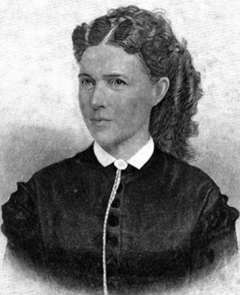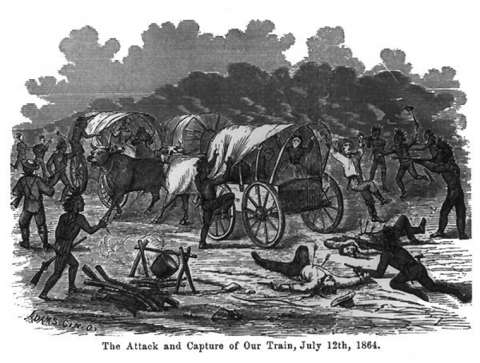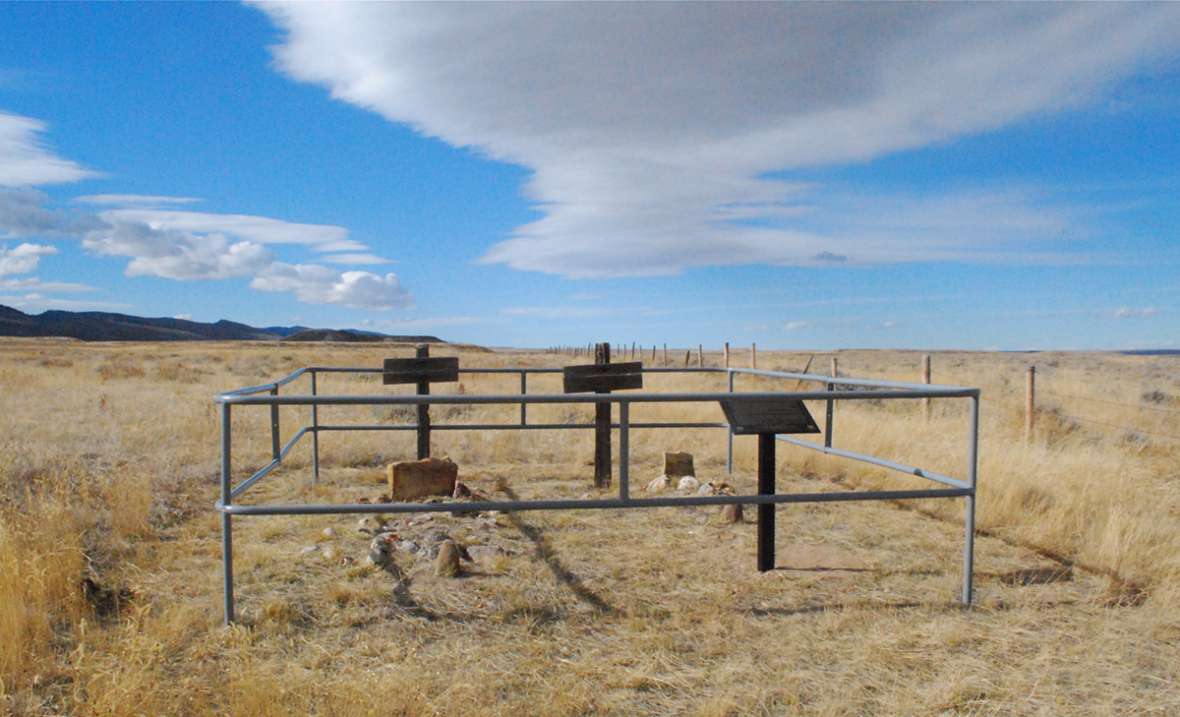- Home
- Encyclopedia
- Attack On The Kelly-Larimer Wagon Train
Attack on the Kelly-Larimer Wagon Train
Late one afternoon in July 1864, a party of American Indians rode up to a small wagon train on the Oregon Trail and, using signs, asked in a friendly way for something to eat. The emigrant party consisted of only 11 people in five wagons. They gave the Indians bread, sugar and tobacco, which seemed to please them, and the tribesmen joined the pioneers on their journey.

As sundown neared, the emigrants discovered the party had grown: Now there were 80 or 100 Indians among them. The Indians asked for supper and indicated they would leave afterwards. The emigrants complied and when they found a likely campsite near Little Box Elder Creek, pulled in for the night. They were on the trail about 120 miles northwest of Fort Laramie, in what’s now Converse County, Wyoming.
These emigrants were extremely well supplied. They were, primarily, two families, the Kellys and the Larimers, who had known each other well in eastern Kansas and were headed now for the new gold camps of western Montana Territory—Virginia City and Bannack.
According to a damage claim filed later, the Kelly family alone was carrying 2,500 pounds of flour, 500 pounds of coffee, 500 pounds of dried fruit, dry goods, “ready made clothing” and three 15-gallon kegs of liquor. They planned to stock a store or hotel to cater to the Montana miners. They also planned to start a dairy, and were driving, in addition to the oxen that pulled their wagons, 50 milk cows and 25 calves.
Josiah and Fanny Kelly were traveling with their adopted daughter, Mary, 7 years old; two hired men, Andy and Franklin Sullivan, father and son, African-Americans and ex-Cherokee slaves; a single man named Gardner Wakefield and “the Rev. Mr. Sharp,” as Fanny Kelly described him later. Andrew Sharp was an aged Methodist pastor, nearly blind but with his own wagon. The Kellys had met him on the trail a few weeks before.
Traveling with the Kellys were William and Sarah Larimer, their son Frank, 8, and a hired wagon driver, Noah Daniel Taylor. Both families had left Kansas in mid-May. The Larimers had traveled for two weeks with a much larger train, and then joined the Kellys on the trail. Sarah Larimer was a commercial photographer; the Larimers were carrying photographic equipment apparently in hopes of setting up a studio in the mining camps.
Stage and freight traffic bound for Oregon, Utah or California by this time moved primarily on the Overland Trail across what’s now southern Wyoming; much of the Euro-American traffic on the older so-called Oregon Trail across what’s now central Wyoming that year was, like the Kellys and Larimers, headed for Montana.
The Bridger and Bozeman trails left the Oregon Trail and headed northwest toward Montana through Indian lands. The tribes were incensed about these new developments. No one had consulted them. Relations with whites were bad and before the year was out would get much worse.
The warriors who joined the Larimers and Kellys that afternoon were mostly Oglala Sioux, with a scattering also from Hunkpapa, Yankton and Blackfoot Sioux bands. The Oglala, especially, would oppose white travel along the Bozeman route and the U.S. Army soldiers sent to protect it in the coming years, in what came to be called Red Cloud’s War.
But the Kellys and Larimers appear to have been unaware of these tensions. At road ranches and trading posts farther east along the trail, they had heard only ridicule of the Indians’ war-making abilities and assurances the road was safe. “We have not had any trouble with the Indians yet,” Noah Taylor, the wagon driver, had written home from Fort Laramie a week earlier. “They appear to be friendly.”
So on that ill-fated evening in July 1864, the Larimers, the Kellys and their hired men busied themselves unhitching teams, building fires, pulling food from wagons and gathering wood.
The attack
No one was looking when the warriors raised their guns and bows. The Rev. Sharp, Taylor the wagon driver, and Franklin the younger ex-slave fell dead at the first volley.

Wounded, William Larimer and Wakefield, the single man, hobbled off as quickly as they could. Josiah Kelly, unarmed and cut off from his family, dove into the brush in a nearby ravine, and the warriors did not go after him.
Just then, another wagon appeared over the ridge from the east. The Indians killed an outrider; the man and woman in the wagon managed to turn the team quickly and, with their small child, escaped back the way they had come.
In camp, the warriors began plundering the Kelly and Larimer wagons, leaving “flower sacs & feather beds riped open & all emptied out on the ground to gather trunks & boxes thrown out of the wagons & broken open & robed & what they could not carry off destroyed there on the ground then they packed their ponies …” Fanny Kelly wrote later. She and her adopted daughter Mary were placed on one horse, Sarah Larimer and her son Frank on another, and the whole party started off for a large village to the north, in the Powder River country.
That night, with her mother’s help, little Mary as she is called in the accounts, managed to slip away. Fanny Kelly, too, escaped, but the Indians found her and angrily brought her back into the group. In the darkness, they continued north and crossed the North Platte, perhaps about where the Dave Johnston Power Plant, east of Glenrock, Wyo., is now.
Little Mary made her way back a short way along the trail, and probably slept by the creek that night. In the morning, she was seen on distant bluffs by three soldiers traveling the trail. Having passed the scene of the attack, the soldiers were nervous. They feared she was being shown to them as decoy for an ambush, and so took a roundabout route and lost sight of her. Four Indians dashed up; the soldiers dismounted and fired, and the Indians kept their distance after that. Mary was found dead on the trail the next day by a party of emigrants. She had been shot with arrows, tomahawked and scalped.
The aftermath
After just two nights, Sarah Larimer and young Frank escaped their captors with the help of a friendly Indian in the band and made their way back to the trading post at Deer Creek, site of present Glenrock.
Fanny Kelly, however, was in captivity five more months, “enduring,” writes trails historian and retired schoolteacher Randy Brown, “many hardships.” Josiah Kelly commissioned various Indian men to go out solo to the villages to find her, but with no luck.
Fanny’s release was finally arranged by some of the Blackfoot Sioux, who were looking to make a separate peace. She was turned over in December to the Army at Fort Sully on the Missouri River in what’s now South Dakota, and Josiah rejoined her there in February 1865.
Gardner Wakefield, meanwhile, lingered at the Deer Creek post in steadily failing health, and finally died of his wounds eight months after the attack.
Josiah and Fanny returned to eastern Kansas and started a hotel in Ellsworth. He died there of cholera in July 1867. Fanny gave birth to a son the following month. Nearly penniless, she made her way to the new railroad town of Sherman Station, on the Union Pacific Railroad at the summit of the Laramie Range between Cheyenne and Laramie. There, the Larimers had set up a photography studio.
Fanny and Sarah Larimer agreed that they would jointly write a book about the attack and their experiences in captivity; Fanny by this point apparently had already written a manuscript of some length. Sarah took that manuscript with her to Philadelphia, where she found a publisher and published the book under her name alone. Fanny sued the Larimers and in 1874 won a judgment of $285.50. The Larimers appealed, and finally settled for an undisclosed amount.
In the intervening years, however, Fanny continued working to advance her interests. She published an account of her own, Narrative of My Captivity among the Sioux Indians, which sold very well. She traveled to Washington, D.C., to press Congress to pass a bill compensating her for her losses in the attack. Congress eventually granted her $10,000. She invested in Washington real estate, married again in 1880, bought a mansion in Maryland in 1893 and died a wealthy woman in 1904, at the age of 59.
The graves
The day after the attack, the bodies of the Rev. Sharp, Noah Taylor, the hired man Franklin and the rider who came late to the scene of the attack were buried on the west side of Little Box Elder Creek by members of an wagon train that had been traveling a day or so behind the Kellys and Larimers.
The travelers placed a buffalo robe over the four corpses and, and, after some discussion about whether it was proper to bury a black man together with the white men, buried them all in a single, wide grave.
“Poor Franklin had shared death with our companions,” Fanny Kelly wrote years later, “and was not deemed unworthy to share the common grave of his fellow victims.” The emigrants mounded the grave with dirt and rocks. Sometime later the grave was marked with wooden markers identifying the dead.
West of the crossing, near the crest of the divide between Little Box Elder and Box Elder creeks, Mary was buried just south of the trail. Her father marked the grave with a wooden headboard. The wooden markers did not last long, and the graves were more or less forgotten.
In 1945, trails enthusiast W.W. Morrison of Cheyenne became interested in the events of the attack and with his daughter, Wanda, began spending part of each summer researching on Little Box Elder Creek. He found the larger grave near the crossing in the creek bottom. Near the crest of the next rise to the west, he found what he thought must be Mary’s grave. Morrison marked both spots with wooden markers and for many years returned each summer to make sure they were in good shape.
In 1954, a small dam, which would flood the trail crossing and the grave of the four men, was built across Little Box Elder Creek about 100 yards below the crossing. L.C. Bishop, Wyoming state engineer—that is, the state’s chief water-law officer—arranged to move the remains of the four men. Bishop had grown up on a ranch on nearby La Prele Creek and knew the area well. The remains of the men—parts of four skulls, a lower jaw, and miscellaneous other bones—were wrapped in a blanket, tied with baling wire and reburied near what Morrison believed to be Mary Kelly’s grave. All were marked with new markers; Bishop and Morrison spoke at a dedication ceremony May 30, 1954.
Late in 1954, the Wyoming Historical Landmark Commission put up a stone marker on U.S. Highway 20-26 a few miles north of the gravesites, naming the emigrants and the date of their deaths. When Interstate 25 was built in the early 1960s, the monument was removed and spent nearly 25 years in so-called storage under a tree in Guernsey State Park.
In 1966, members of the Wyoming State Historical Society together with Chicago businessman John H. Wiggins, a first cousin of Mary Kelly, erected a chain-link fence around the graves.
Finally, thanks to the efforts of Randy Brown of the Oregon-California Trails Association and Bruce Nichols of the Wyoming State Historic Preservation Office, the monument was re-erected at a turnout on I-25 about two miles west of the Natural Bridge exit, where it remains today.
By the mid-2000s, the 1960s fence around the graves was falling down. With the help of local trail enthusiasts and two of his students, Brown replaced the fence.

Resources
- Brown, Randy. “Attack on the Kelly-Larimer Wagon Train.” Overland Journal 5, no. 1 (Winter 1987): 16-40.
- ____________. Email to WyoHistory.org, Jan. 13, 2016.
- Wyoming State Historic Preservation Office. “Kelley Larimer Massacre Site and the Mary Hurley Grave.” Emigrant Trails throughout Wyoming. Accessed Jan. 15, 2016 at http://wyoshpo.state.wy.us/trailsdemo/kelly-larimer.htm.
For further reading and research
- Kelly, Fanny. Narrative of My Captivity Among the Sioux Indians. Chicago: R. R. Donelley and Sons, 1891. First published 1871. Accessed Jan. 12, 2016, at https://books.google.com/books?id=wn8TAAAAYAAJ&printsec=frontcover&source=gbs_ge_summary_r&cad=0#v=onepage&q&f=false.
Illustrations
The portrait of Fanny Kelly and the illustration of the wagon train attack are both from her book, Narrative of My Captivity Among the Sioux Indians, first published in 1871. The portrait came to us via Find A Grave, and the attack scene via Historynet. Used with thanks.
